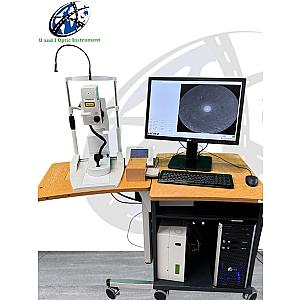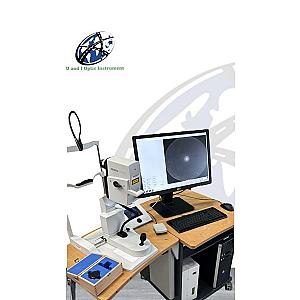The HRA 2 is a confocal scanning laser ophthalmic diagnostic system designed for fluorescein and indocyanine green angiography. Providing high-precision digital retinal imaging, it enables the acquisition of single-layer, time-sequence, or three-dimensional images. Thanks to its multiple laser wavelengths and its ability to perform combined imaging modalities, the HRA 2 stands out as an essential tool for the screening and monitoring of retinal pathologies.
Confocal Retinal Angiography Device HRA 2 - Good Condition







Description
Confocal Scanning Retinal Imaging: The Excellence of Heidelberg’s HRA 2
The HRA 2 by Heidelberg is an ophthalmic diagnostic system based on confocal scanning laser technology. It captures high-contrast retinal images with or without contrast agents, facilitating the detection of both vascular and structural abnormalities. Using a two-dimensional laser scanning mechanism that focuses light on specific retinal areas, it generates remarkably contrasted images. The confocal rejection of out-of-focus light ensures clear imaging by eliminating stray signals, delivering optimal image quality even in deeper layers—particularly valuable in indocyanine green angiography.
The device features three distinct laser sources: a 488 nm semiconductor laser for fluorescein angiography, a 795 nm diode laser for indocyanine green, and an 830 nm diode laser for infrared reflectance imaging. These wavelengths allow for precise mapping of retinal vascularization. In simultaneous imaging mode, the HRA 2 scans each image line twice, capturing both dye signals in parallel. This dual capture capability enhances clinical relevance while streamlining examination protocols.
Images are acquired in high resolution up to 1536 x 1536 pixels, and are immediately digitized and stored on the control computer. The system offers adjustable fields of view—15°, 20°, and 30°—with the ability to create panoramic composites up to 120°. Deep layer explorations, similar to tomography, are also possible through sequential layered image capture.
The system includes a laser scanning camera, a touchscreen control panel, a laser module power supply, a computer with dedicated software, and an isolation transformer compliant with IEC 60601-1 standards. Operation is guided via an intuitive interface using a touchscreen, keyboard, or footswitch. Sensor sensitivity, focus, and scanning parameters are finely adjustable to ensure image acquisition tailored to each clinical scenario.
The HRA 2 combines technological precision, ergonomic design, and flexible operation, supporting eye care professionals in their most complex diagnostic challenges.
Features
- Confocal scanning system for digital angiography
- Single-layer, time-lapse, or 3D image acquisition
- Separate or simultaneous modes for fluorescein and indocyanine green angiography
- Precise filtering of out-of-focus light signals
- Real-time adjustable sensor sensitivity
- Ergonomic interfaces: touchscreen, footswitch, keyboard
- Compatible with Heidelberg Eye Explorer software for analysis and archiving
Technical Details
- Field of view: 15°, 20°, 30° (composite up to 120°)
- Focusing range: –12 to +12 diopters, in 0.25 D increments
- Available resolutions: High resolution: up to 1536 x 1536 pixels
- Maximum frame rate: High resolution: up to 9 Hz; Fast mode: up to 16 Hz
- Z-scan depth: up to 8 mm
- Digital resolution: 5 µm/pixel (HR), 10 µm/pixel (HS)
- Laser sources: 488 nm (FA), 795 nm (ICGA), 830 nm (IR)
- Power consumption: 70 W
- Input voltage: 100–240 V / 50–60 Hz
Compatible Accessories
- Fluorescein sodium and indocyanine green dyes
- Corrective lenses for astigmatic patients (>2D)
- Additional patient headrests and fixation supports
- External storage devices for archiving (FireWire hard drive)
- Lens cleaning supplies (acetone and lint-free cotton)
- Heidelberg software updates and optional add-on modules